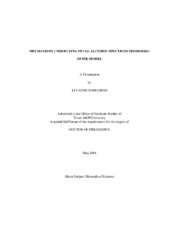| dc.description.abstract | Maternal alcohol abuse during pregnancy can result in a range of structural and
functional abnormalities that include lifelong physical, mental, behavioral and learning
disabilities, now collectively termed as Fetal Alcohol Spectrum Disorders (FASD). The
incidence of FASD is now estimated be as high as 10 per 1000 live births. Each year,
40,000 babies are born with FASD in the United States at an estimated cost of $1.4
million per individual and total cost of $6 billion. Because of the magnitude of this
problem and because the incidence has not decreased in spite intensive efforts to educate
women to not abuse alcohol during pregnancy, ways to prevent or mitigate the effects of
prenatal alcohol exposure must be explored in addition to education. Therefore, we
wished to identify the precise mechanisms by which alcohol mediates the
neurodevelopmental damage in order to develop intervention/amelioration strategies.
The present study was conducted using an ovine model system. The large body
mass of the ovine fetus, the longer gestation that is more similar to that of humans, and
that all three trimester equivalents occur in utero, make the sheep an excellent model to
study the effects of alcohol on the developing fetus. Our study establishes that maternal alcohol exposure does not result in fetal cerebral hypoxia. Instead, alcohol results in
hypercapnea and acidemia leading to a cascade of events in the maternal and fetal
compartments that include deficits in the levels of glutamine and glutamine-related
amino acids, alterations in endocrine axes, oxidative stress, alteration in cardiovascular
homeostasis and fetal neuronal loss. Further, we demonstrate that inhibiting the novel
two-pore domain acid sensitive potassium channel (TASK) expressed in the cerebellar
granule cells and the peripheral and central chemoreceptors may prove to a be potential
therapeutic strategy. Preventive strategies that are safe to use in pregnant women and
that involve glutamine-related pathways are also suggested. Finally, the study also
establishes the beneficial effects of moderate alcohol consumption on the fetal skeletal
system. | en |


